
Primary Sources vs. the Public Space: The Case of the Metro
May 27, 2018Work with historical sources, interest in the public space, and bringing together various target groups are all characteristic features of CTG’s work in the field of historical education about socialism. On April 27th, we held our “History on the Metro” workshop, which dealt with the theme of the construction of Prague’s metro. The first section of the Prague metro was put into service in 1974, in one of Czechoslovakia’s most significant building projects of the period. The goal of the workshop was to discuss the educational potential of the Prague metro, and of transportation constructions more generally, with participants. Some of the participants were history teachers from middle schools and high schools, and others were history students interested in the educational side of their subject.
We selected the entrance hall of the Muzeum metro station for our participants’ meeting point. The station is located at the main train station in the city center, and it was built as a representative space, connecting the period’s high technological level of advancement in terms of public transportation in Prague with the proximity to the historical core of the city, in particular the National Museum. For our introduction, we led a discussion on how to change the everyday city space into a place open to educational activities. We particularly emphasized building the ability to look for and “read” various historical layers and meanings in the public space.
In order to further develop this skill, we prepared a number of sets of historical sources, which we provided to the participants in digital form on our tablets. They included, for example, period designs and plans for building the Prague metro network, photos from the construction, and maps of the original station names, which were influenced by the socialist ideology. Participants were able to bring these sources face to face with what the metro looks like today. We also familiarized ourselves with the arguments that took place surrounding the project during the time of its construction.
In other parts of the workshop, the participants broke off into smaller groups to focus on looking for and photographing artwork and other original and contemporary elements in the interiors of various stations. Along with group work and discussion, another part of the workshop was a short performance in the Dejvicka station vestibule, where two actors portrayed several situations pointing out the original name of the station: Leninova. The goal was to make sources that rely on the metro’s space from the time of its construction visible, and also to show alternative ways of reading the contemporary space by pointing out the hidden elements of socialist design or changes to the name of the station.



We moved from in from the field to the classroom for our last activity, in which participants had the task of proposing a concept for a “museum of the metro.” In this activity, the educational potential of the public space became the most evident, and we can summarize it in the following points:
1. Metro systems (and technical constructions generally) carry imprints of the period in which they were built, including in ideological, aesthetic, and technical-economic terms or from the perspective of the city’s development.
2. Focusing on educational work in the contemporary public space allows you to more easily and believably connect the past with the present, because many decisions made in the past influence the functioning and form of Prague’s public transportation system today.
3. Methods for working with the public space that revealed the confrontation between the current condition and the historical sources, and detailed explorations of one station or section of the metro, proved to be fitting.
4. The performance, which disturbed the normal pattern of behavior in the metro space, ended up being successful.
Thus, from an educational perspective, the metro has proved to be like its own museum, which is available seven days a week at a relatively low cost and which allows for a broad range of educational activities dealing with contemporary history. These activities can also apply in different areas of the city and with different types of constructions.
